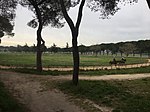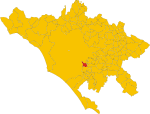Santuario della Madonna del Divino Amore
1745 establishments in Italy18th-century Roman Catholic church buildings in Italy20th-century Roman Catholic church buildings in ItalyRoman Catholic churches completed in 1745Roman Catholic churches in Rome ... and 1 more
Titles of Mary

Santuario della Madonna del Divino Amore, or the Shrine of Our Lady of Divine Love, is a Roman Catholic shrine in the southern outskirts of Rome dedicated to the Blessed Virgin Mary that consists of two churches: an old church built in 1745 and a new church added to the sanctuary in 1999. The church was included by Pope John Paul II in the pilgrimage of Seven Pilgrim Churches of Rome during the Holy Year 2000.
Excerpt from the Wikipedia article Santuario della Madonna del Divino Amore (License: CC BY-SA 3.0, Authors, Images).Santuario della Madonna del Divino Amore
Via del Santuario, Rome Municipio Roma IX
Geographical coordinates (GPS) Address External links Nearby Places Show on map
Geographical coordinates (GPS)
| Latitude | Longitude |
|---|---|
| N 41.778611111111 ° | E 12.543611111111 ° |
Address
Nuovo Santuario Divino Amore
Via del Santuario
00134 Rome, Municipio Roma IX
Lazio, Italy
Open on Google Maps










